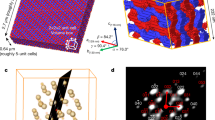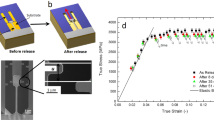Abstract
Highly ordered soft materials exhibit Bragg peaks that cannot be indexed assuming homogeneous crystal structures. Their origin has been attributed to changes in the crystal structure that are induced by the ordering process such as by application of external fields. This would restrict the use for the generation of highly ordered nano- and microstructured materials where a homogeneous crystal structure is a key requirement. Here, we demonstrate that these Bragg peaks are an inherent property of homogeneous ordered soft materials related to the finite coherence of their crystalline lattice. Their consideration allows a detailed and quantitative analysis of the diffraction patterns of seemingly unrelated materials such as lyotropic liquid-crystalline phases, mesoporous materials, colloidal dispersions, block copolymers, electrorheological fluids and photonic crystals. It further enables us to develop a concise picture of order, line density, field-induced orientation and epitaxial relations for soft-material lattices.
This is a preview of subscription content, access via your institution
Access options
Subscribe to this journal
Receive 12 print issues and online access
$259.00 per year
only $21.58 per issue
Buy this article
- Purchase on Springer Link
- Instant access to full article PDF
Prices may be subject to local taxes which are calculated during checkout




Similar content being viewed by others
References
De Gennes, P. G. Soft matter: More than words. Soft Matter 1, 16 (2005).
Hamley, I. W. Introduction to Soft Matter, Polymers, Colloids, Amphiphiles and Liquid Crystals (Wiley, Chichester, 2000).
Buitenhuis, J. & Förster, S. Block copolymer micelles: Viscoelasticity and interaction of soft spheres. J. Chem. Phys. 107, 262–272 (1997).
Liu, T., Burger, C. & Chu, B. Nanofabrication in polymer matrices. Prog. Polym. Sci. 28, 5–26 (2003).
Ackerson, B. J., Hayter, J. B., Clark, N. A. & Cotter, L. Neutron scattering from charge stabilized suspensions undergoing shear. J. Chem. Phys. 84, 2344–2349 (1986).
Ashdown, S. et al. Small-angle neutron scattering studies on ordered polymer colloid dispersions. Langmuir 6, 303–307 (1990).
Laun, H. M. et al. Rheological and small angle neutron scattering investigations of shear-induced particle structures of concentrated polymer dispersions submitted to plane Poiseuille and Couette flow. J. Rheol. 36, 743–787 (1992).
Loose, W. & Ackerson, B. J. Model calculations for the analysis of scattering data from layered structures. J. Chem. Phys. 101, 7211–7220 (1994).
Panine, P., Narayanan, T., Vermant, J. & Mewis, J. Structure and rheology during shear-induced crystallization of a latex suspension. Phys. Rev. E 66, 022401 (2002).
Vigild, M. E. et al. Transformations to and from the gyroid phase in a diblock copolymer. Macromolecules 31, 5702–5716 (1998).
Petukhov, A. V., Dolbnya, I. P., Aarts, D. G. A. L., Vroege, G. J. & Lekkerkerker, H. N. W. Bragg rods and multiple X-ray scattering in random-stacking colloidal crystals. Phys. Rev. Lett. 90, 028304 (2003).
Förster, S. et al. Scattering curves of ordered mesoscopic materials. J. Phys. Chem. B 109, 1347–1360 (2005).
Molino, F. R., Berret, J.-F., Porte, G., Diat, O. & Lindner, P. Identification of flow mechanisms for a soft crystal. Eur. Phys. J. B 3, 59–72 (1998).
McConnell, G. A., Lin, M. Y. & Gast, A. P. Long range order in polymeric micelles under steady shear. Macromolecules 28, 6754–6764 (1995).
Diat, O., Porte, G. & Berret, J.-F. Orientation and twins separation in a micellar cubic crystal under oscillation shear. Phys. Rev. B 54, 14869–14872 (1996).
Park, M. J., Char, K., Bang, J. & Lodge, T. P. Interplay between cubic and hexagonal phases in block copolymer solutions. Langmuir 21, 1403–1411 (2005).
Leyh, B., Creutz, S., Gaspard, J.-P., Bourgaux, C. & Jerome, R. Shear-induced order in aqueous micellar solutions of amphiphilic poly(tert.-butylstyrene)-b-poly(Na methacyrlate) diblock. Macromolecules 31, 9258–9264 (1998).
Deng, Y. et al. Bulk morphology and micellization of poly(diene)-poly(ethylene oxide) diblock copolymers in water. Polymer 43, 7155–7160 (2002).
Park, M. J., Bang, J., Harada, T., Char, K. & Lodge, T. P. Epitaxial transitions among FCC, HCP, BCC, and cylinder phases in a block copolymer solutions. Macromolecules 37, 9064–9075 (2004).
Vos, W. L., Megens, M., van Kats, C. M. & Bösecke, P. X-ray diffraction of photonic colloidal single crystals. Langmuir 13, 6004–6008 (1997).
Hajduk, D. A. et al. The gyroid: A new equilibrium morphology in weakly segregated diblock copolymers. Macromolecules 27, 4063–4075 (1994).
Schulz, M. F., Bates, F. S., Almdal, K. & Mortensen, K. Epitaxial relationship for hexagonal-to-cubic phase transition in a block copolymer mixture. Phys. Rev. Lett. 73, 86–89 (1994).
Förster, S. et al. Complex phase behavior of polyisoprene-polystyrene diblock copolymers near the order-disorder transition. Macromolecules 27, 6922–6935 (1994).
Fairclough, J. P. A. et al. Crystallization in block copolymer melts: Small soft structures that template larger hard structures. J. Chem. Phys. 114, 5425–5431 (2001).
Azaroff, L. V. Elements of X-ray Crystallography (McGraw-Hill, New York, 1968).
Hentze, H. P., Krämer, E., Berton, B., Förster, S. & Antonietti, M. Lyotropic mesophases of poly(ethylene oxide)-b-poly(butadiene) diblock copolymers and their cross-linking to generate ordered gels. Macromolecules 32, 5803–5809 (1999).
Shefelbine, T. A. et al. Core-shell gyroid morphology in a poly(isoprene-block-styrene-block-dimethylsiloxane) triblock copolymer. J. Am. Chem. Soc. 121, 8457–8465 (1999).
Koppi, K. A., Tirrell, M., Bates, F. S., Almdal, K. & Mortensen, K. Epitaxial growth and shearing of the body centered cubic phase in diblock copolymer melts. J. Rheol. 38, 999–1027 (1994).
Papadakis, C. M., Almdal, K., Mortensen, K., Vigild, M. E. & Stepanek, P. Unexpected phase behavior of an asymmetric diblock copolymer. J. Chem. Phys. 111, 4319–4326 (1999).
Papadakis, C. M., Rittig, F., Almdal, K., Mortensen, K. & Stepanek, P. Collective dynamics and self-diffusion in a diblock copolymer melt in the body-centered cubic phase. Eur. Phys. J. E 15, 359–370 (2004).
Hamley, I. W., Mai, S.-M., Ryan, A. J., Fairclough, J. P. A. & Booth, C. Aqueous mesophases of block copolymers of ethylene oxide and 1,2-butlyene oxide. Phys. Chem. Chem. Phys. 3, 2972–2980 (2001).
Mortensen, K., Theunissen, E., Kleppinger, R., Almdal, K. & Reynaers, H. Shear-induced morphologies of cubic ordered block copolymer micellar networks studied by in situ small-angle neutron scattering and rheology. Macromolecules 35, 7773–7781 (2002).
Mortensen, K. J. Three-dimensional crystallographic determination of the body-centered-cubic morphologies of shear-aligned block copolymer systems. Polym. Sci. B 42, 3095–3101 (2004).
Matsen, M. W. Cylinder-gyroid epitaxial transitions in complex polymeric liquids. Phys. Rev. Lett. 80, 4470–4473 (1998).
Hajduk, D. A., Ho, R.-M., Hillmyer, M. A., Bates, F. S. & Almdal, K. Transition mechanisms for complex ordered phases in block copolymer melts. J. Phys. Chem. B 102, 1356–1363 (1998).
Förster, S. et al. Lyotropic phase morphologies of amphiphilic block copolymers. Macromolecules 34, 4610–4623 (2001).
Pople, J. A. et al. Ordered phases in aqueous solutions of diblock oxyethylene/oxybutylene copolymers investigated by simultaneous small-angle X-ray scattering and rheology. Macromolecules 30, 5721–5728 (1997).
Wentzcovitch, R. M. & Krakauer, H. Martensitic transformation of Ca. Phys. Rev. B 42, 4563–4567 (1990).
Kotlarchyk, M. & Chen, S.-H. Analysis of small angle neutron scattering spectra from polydisperse interacting colloids. J. Chem. Phys. 79, 2461–2469 (1983).
Förster, S. & Krämer, E. Synthesis of PB-PEO and PI-PEO block copolymers with alkyllithium initiators and the phosphazene base t-BuP4 . Macromolecules 32, 2783–2785 (1999).
Lindner, P. & Zemb, Th. Neutrons, X-rays and Light: Scattering Methods Applied to Soft Condensed Matter (Elsevier, Amsterdam, 2002).
Acknowledgements
Financial support of the DFG-Graduiertenkolleg GK611 is gratefully acknowledged.
Author information
Authors and Affiliations
Corresponding author
Ethics declarations
Competing interests
The authors declare no competing financial interests.
Supplementary information
Supplementary Information
Supplementary figures S1-S3 (PDF 228 kb)
Rights and permissions
About this article
Cite this article
Förster, S., Timmann, A., Schellbach, C. et al. Order causes secondary Bragg peaks in soft materials. Nature Mater 6, 888–893 (2007). https://doi.org/10.1038/nmat1995
Received:
Accepted:
Published:
Issue Date:
DOI: https://doi.org/10.1038/nmat1995
This article is cited by
-
Forced to line up for perfect order
Nature Materials (2019)
-
Superstructures generated from truncated tetrahedral quantum dots
Nature (2018)
-
Interference Effects in Nanocrystalline Systems
Metallurgical and Materials Transactions A (2013)
-
Complex order in soft matter
Nature (2011)



